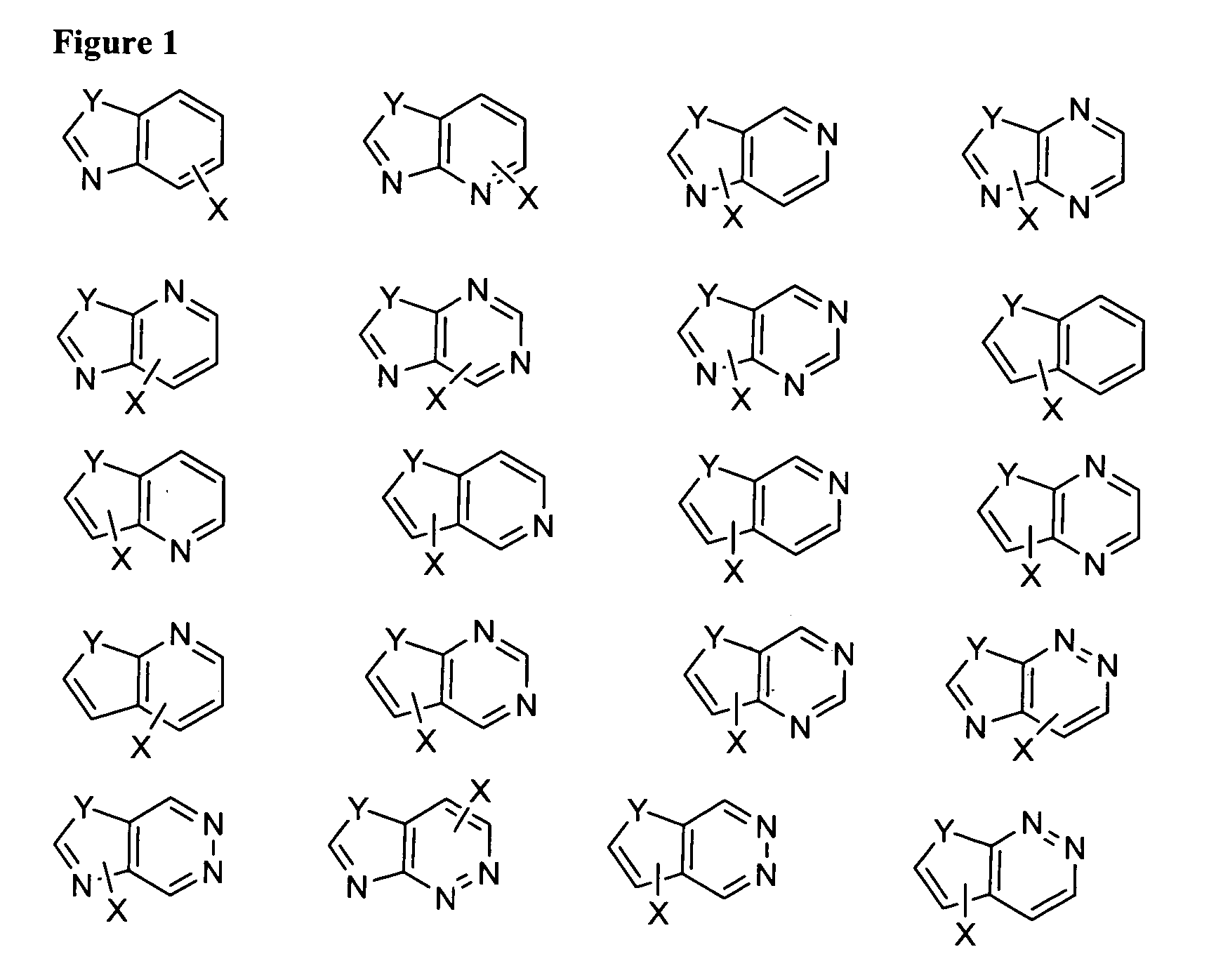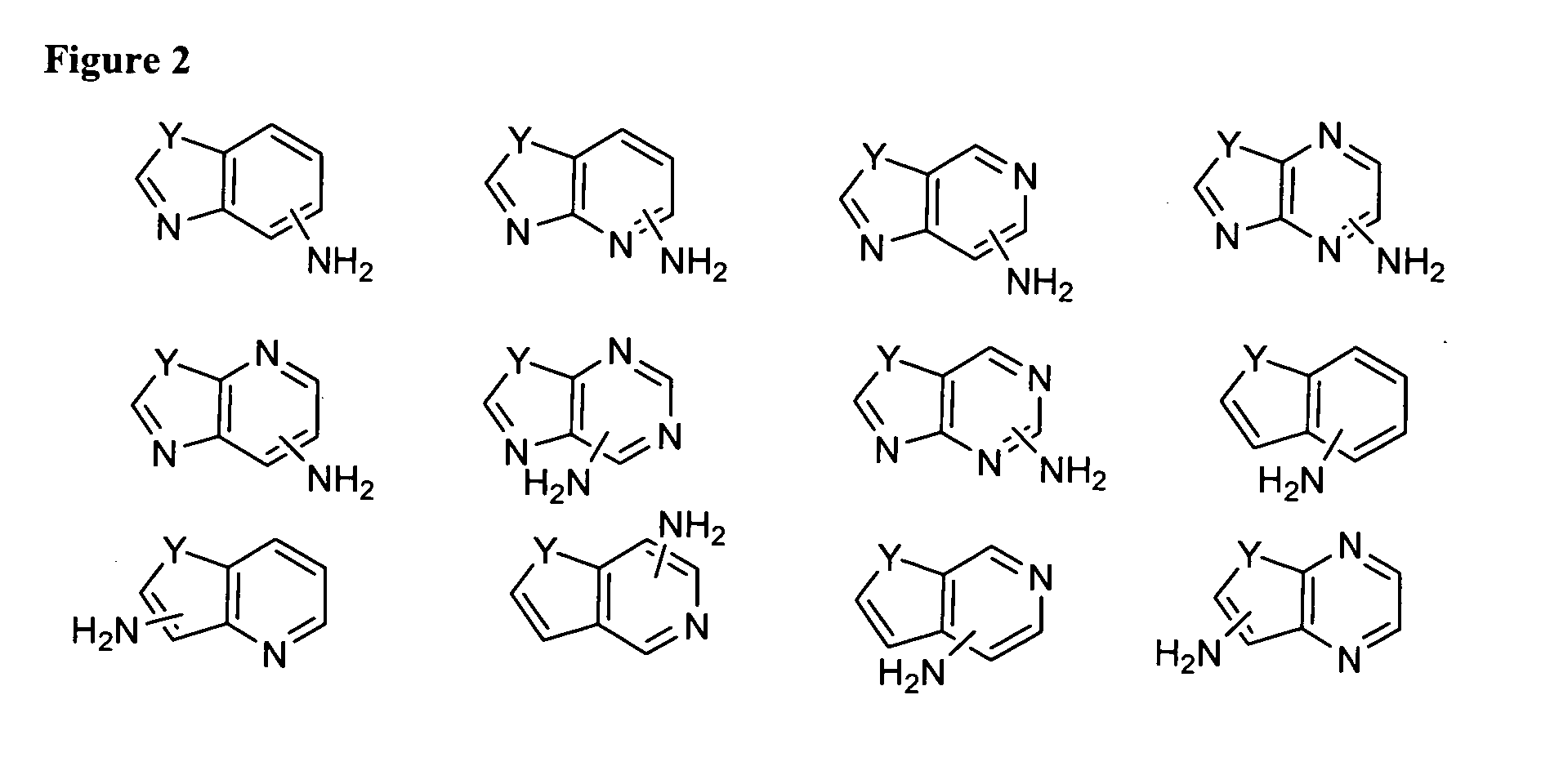C-linked cyclic antagonists of P2Y1 receptor useful in the treatment of thrombotic conditions
a cyclic antagonist and p2y1 technology, applied in the field of c-linked cyclic compounds, can solve the problems of in vivo study of the pharmacological properties of the antagonists, and achieve the effect of reducing the risk of thrombosis
- Summary
- Abstract
- Description
- Claims
- Application Information
AI Technical Summary
Benefits of technology
Problems solved by technology
Method used
Image
Examples
example 1
1-(2-(1H-indol-2-yl)phenyl)-3-(4-tert-butylphenyl)urea
[0341] To a solution of commercially available 2-(1H-indol-2-yl)benzenamine (62 mg, 0.3 mmol) in dichloromethane (1.5 mL) at rt was added 4-tert-butylphenyl isocyanate (30 mg, 0.171 mmol). The reaction was stirred overnight at rt. Hexane (1 mL) was added to the reaction mixture and the reaction was allowed to set for ˜5 min. Example 1 was the solid formed which was collected by filtration (47.3 mg). (M+H)+=384.37.
[0342] Examples 2-5 listed below were made following the procedure described for Example 1.
example 6
N-(2-(1H-indol-2-yl)phenyl)-4-tert-butylthiazol-2-amine
[0343] 6a. 1-(2-(1H-indol-2-yl)phenyl)thiourea: To a solution of commercially available 2-(1H-indol-2-yl)benzenamine (111 mg, 0.534 mmol) in THF (3.5 mL) was added benzoyl isothiocyanate (79 μL, 0.587 mmol). The reaction was capped and heated at 50° C. with stirring for 2 h. MeOH (1.0 mL) and 2.0M LiOH in water (0.54 mL) was added and the reaction was stirred overnight at 50° C. The reaction was extracted into ethyl acetate (10 mL) and washed with sat. NaCl solution (˜4 mL). The organic layer was dried over MgSO4, filtered and concentrated. The residue was taken up in dichloromethane (˜5 mL) and hexane was added slowly to initiate precipitation. Once cloudy appearance observed, addition of hexane was stopped and the reaction was allowed to set for 5-10 min to allow the precipitation to form. Additional hexane was then added (˜2 mL) and the solid was collected by filtration to provide 6a (103 mg). (M+H)+=268.3.
[0344] Example 6....
example 7
1-(2-(1H-indol-2-yl)pyridin-3-yl)-3-(4-(trifluoromethoxy)phenyl)urea
[0345]
[0346] 7a. 2-(3-nitropyridin-2-yl)-1H-indole:2-Bromo-3-nitropyridine (0.43 g, 2.13 mmol), 1-(tert-butoxycarbonyl)-1H-indol-2-ylboronic acid (0.75 g, 2.87 mmol, 1.3 eq), Pd(PPh3)4 (0.47 g, 20% mol), and 2N Na2CO3 (0.45 g in 2.1 mL H2O, 4.26 mmol, 2 eq) were stirred in DME (10 mL) at rt. The mixture was degassed 3 times and purged with N2. It was then heated at 80° C. for 15 h under N2. LC-MS of reaction mixture showed both tert-butyl 2-(3-nitropyridin-2-yl)-1H-indole-1-carboxylate and 2-(3-nitropyridin-2-yl)-1H-indole. The mixture was cooled to rt, EtOAc was added. It was washed with sat'd NaHCO3, H2O, brine, dried over MgSO4, filtered, and concentrated to dryness. The residue was purified by silica gel chromatography (hexanes / EtOAc) to give only 7a as the desired product (0.24 g, yield: 47%). LC-MS ESI 413.2(10-90% MeOH in H2O with 0.1% TFA in a 4 min run), retention time=3.23 min, 240.1 (M+H), 479.1 (2M+H). ...
PUM
| Property | Measurement | Unit |
|---|---|---|
| Carrier mobility | aaaaa | aaaaa |
| Volume | aaaaa | aaaaa |
| Length | aaaaa | aaaaa |
Abstract
Description
Claims
Application Information
 Login to View More
Login to View More - R&D
- Intellectual Property
- Life Sciences
- Materials
- Tech Scout
- Unparalleled Data Quality
- Higher Quality Content
- 60% Fewer Hallucinations
Browse by: Latest US Patents, China's latest patents, Technical Efficacy Thesaurus, Application Domain, Technology Topic, Popular Technical Reports.
© 2025 PatSnap. All rights reserved.Legal|Privacy policy|Modern Slavery Act Transparency Statement|Sitemap|About US| Contact US: help@patsnap.com



